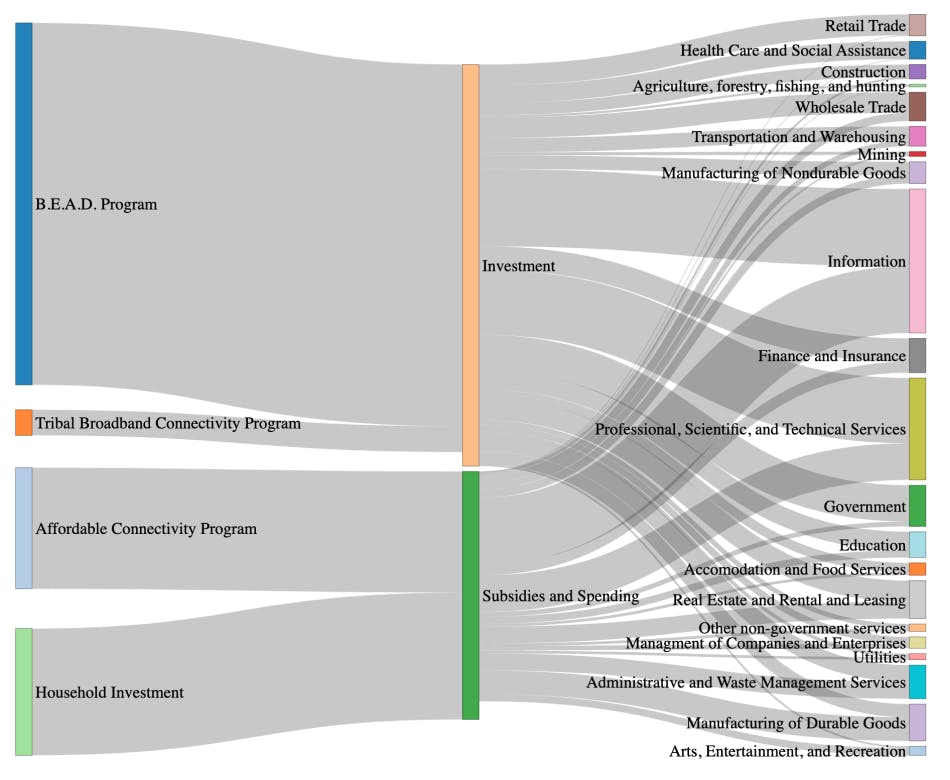Authors:
(1) Matthew Sprintson
(2) Edward Oughton
Table of Links
2. Literature Review
2.1 Reviewing Broadband Infrastructure’s Impact on the Economy
2.2 Previous Research into IO Modeling of Broadband Investment
2.3 Context of the Bipartisan Infrastructure Act through Previous Research
3. Methods and 3.1 Leontief Input-Output (IO) Modeling
3.2 Ghosh Supply-Side Assessment Methods for Infrastructure
4.2 What are the GDP impacts of the three funding programs within the Bipartisan Infrastructure Law?
5. Discussion
5.2 What are the GDP impacts of the three funding programs within the Bipartisan Infrastructure Law?
5.3 How are supply chain linkages affected by allocations from the Bipartisan Infrastructure Law?"
Acknowledgements and References
4.3 How are the supply chain linkages affected by allocations from the Bipartisan Infrastructure Law?
A Sankey diagram is presented in Figure 5 visualizing the key linkage impacts of these three initiatives. As illustrated, the indirect benefits ripple throughout all industries, and the overall benefit of broadband infrastructure investments through the BEAD program is greater than that of subsidies in the ACP. Figure 3 displays the inter-sectoral impacts of each bill. Overall, the investment will increase Manufacturing output by US $6.85 billion, which will grow the manufacturing sector by 0.0951% over the next five years.
Other than the Information sector, the Professional, Scientific, and Technical Services sector will increase by US $11.9 billion, or 0.146% over the next five years. Other sectors impacted the most are Real Estate, Rental, and Leasing; Finance and Insurance; and Administrative and Waste Management Services. The Professional, Scientific, and Technical Services sector is currently the fourth largest economic sector, behind Wholesale trade and Construction as defined by the Bureau of Economic Analysis. Those two sectors are projected to grow by US $3.36 billion (.0348%, annually) and US $1.68 billion (.0216%, annually), respectively.
Sectors that are closely dependent on telecommunications are projected to grow, too. Arts, Entertainment, and Recreation, an industry that is linked to advertisement, video streaming, and other resources that depend on reliable Internet connection, are projected to grow by US $1.05 billion (.137%), Although this is one of the smallest sectors of the US economy, new connections to the Internet will spur demand for new goods and services from this sector.
Sectors that are affected the least include Agriculture, Forestry, Fishing, and Hunting ($296 Mn, .0456% growth), Mining ($551 Mn, .0789% growth), and Utilities ($702 Mn, .1068% growth). All three industries are not closely related to the telecommunications industry, with most relying on broadband for sales, input goods, and purchase of capital goods. The relatively high growth rate speaks more to the size of the sectors in comparison to others, as these are also relatively small sectors in the US economy.

This paper is available on arxiv under CC0 1.0 DEED license.

